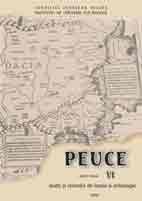Ceramica terra sigillata de la Noviodunum
The Terra Sigillata Ceramic from Noviodunum
Author(s): Victor Heinrich BaumannSubject(s): Archaeology
Published by: Institutul de Cercetari Eco-Muzeale Tulcea - Institutul de Istorie si Arheologie
Keywords: terra sigillata; archaeological site; Noviodunum; Big Tower; Roman Age; manufacture centres; zonă arheologică; Turnul Mare; epocă romană; centre de producţie
Summary/Abstract: The subject of the present study had as a starting point the need to establish chronological references, as precisely as it could, concerning the beginning of the Roman life at Noviodunum. Thus, the author uses as a reference the ceramic category known under the name of terra sigillata, representing a precise instrument of dating and also an informative source upon the economic activities developed at Noviodunum during the Early Roman Age. The most part of the sigillar resource taken into account results from the area of the big tower belonging to the Roman-Byzantine fortress. The phenomenon is due to the archeological researches of vast proportion that led to the discovery of this monument, which superposes the remains of the first Roman fortress from Noviodunum – the land castrum – and was covered by a thick level of soil during the Byzantine period, resulting from the Early Roman living levels. During the twelve campaigns of archeological researches carried out at Noviodunum (between the years 1995 and 2007) there were discovered 101 ceramic fragments of terra sigillata, from which 75 typical fragments belong to the two typological groups known by researchers: TS with ornament and smooth or strip TS. The sigillar material studied at present reflects the main penetrating courses of these imports: coming from the Roman West, the North-Pontic area and South-Moesian region. The first TS imports belong to the Arretin ceramic category characterized by smooth walls and dating back in the first half of the 1st century A.D., most of them representing cups provided by the Romans coming from West. But there are also TS imports of South-Gallic origin, products of the Graufesenque’s officinae (Condatomagus) dated in the time of the imperial Flavians. The 2nd century A.D. is dominated by ceramics imported from the Central Gaul, produced especially in the workshops of Lezoux (Ledosus); starting with the 2nd half of the century the number of the Rhenanian products increases: the main centers are Rheinzabern, from the Eastern Gaul and Westerndorf, from the Upper Germany. Instead, a lack of products of Pannonian origin may be noticed. The author regards the presence of TS products of North-Pontic (salvers and plates produced in the ceramic workshops from Mirmekion and Olbia) and South-Moesian origin (salvers coming from the pottery of Butovo) as an understandable phenomenon in the context of the traditional relations, already existing in the moment of the Roman occupation in this geographical-historical area of the West and North-Pontic seashore. The study of sigillar artifacts from Noviodunum includes also the local production of TS imitations, the workshops present in the area of this fortress starting to produce from the middle of the 2nd century and to impose their products during the 3rd century A.D. Thus, the phenomenon is reflected also by the TS discoveries from the villae rusticate inside the fortress, especially those studied at Nic
Journal: Peuce (Serie Nouă) - Studii şi cercetari de istorie şi arheologie
- Issue Year: VI/2008
- Issue No: 6
- Page Range: 207-250
- Page Count: 44
- Language: Romanian

